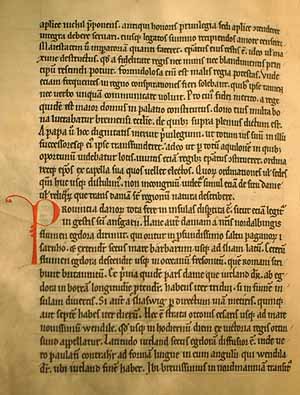Adam of Bremen facts for kids
Adam of Bremen (in Latin: Adamus Bremensis; in German: Adam von Bremen) was an important German writer and historian from the Middle Ages. He lived in the second half of the 1000s. He is best known for his book, Gesta Hammaburgensis ecclesiae pontificum. This long title means Deeds of the Bishops of the Hamburg Church. Adam was born before 1050 and likely passed away around 1081 to 1085. Many people consider him one of the most important historians of his time. He also studied different cultures and peoples.
Contents
Who Was Adam of Bremen?
Not much is known about Adam of Bremen's early life. Most of what we know comes from his own writings. People believe he came from a place called Meißen in Saxony, Germany.
His Education and Learning
Adam was called Magister Adam. This special title shows he had a very good education. He likely studied at a famous school in Magdeburg. His writings show he knew a lot about many different authors and books. This means he was a very well-read person.
Life in Bremen
Around 1066 or 1067, a leader named Archbishop Adalbert of Hamburg invited Adam to join the Church of Bremen. Adam became part of the church leaders in Bremen. By 1069, he was the director of the cathedral's school. This was an important job. Soon after, he began writing his famous history book, the Gesta.
Gathering Information for His Book
Adam's job at the Church of Bremen helped him a lot. The church was very active in spreading its influence. This allowed Adam to collect information about the history and geography of Northern Germany.
He also visited the court of King Svend Estridsen in Denmark. This visit gave him a great chance to learn about Denmark and other Scandinavian countries. He wrote about many things, including important sea routes like the one between Elsinore and Helsingborg.
See also
 In Spanish: Adán de Bremen para niños
In Spanish: Adán de Bremen para niños


